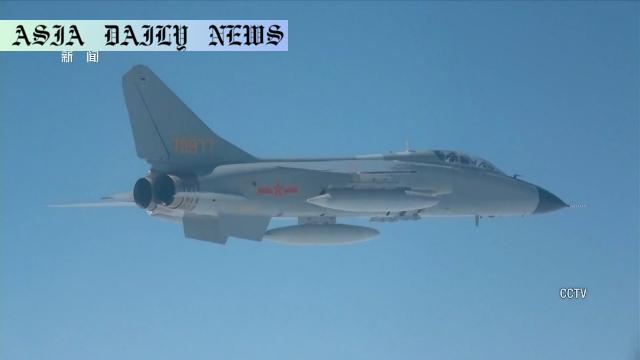Taiwan Strait: China’s military drills heighten tensions as 76 aircraft sorties and 15 vessels encircle Taiwan in planned exercises.
- China’s military conducted intense drills in the Taiwan Strait, with 76 aircraft sorties and 15 vessels spotted near Taiwan in 24 hours.
- China named the operation ‘Strait Thunder-2025A,’ targeting sea blockades and precision strikes as tensions with Taiwan escalate.
- The US condemns China’s aggressive actions, promoting stability in the region and opposing unilateral status quo changes.

China’s Military Escalation in the Taiwan Strait
On Wednesday, China’s military conducted extensive drills in the Taiwan Strait, aiming to showcase its offensive capabilities and strategic strength. Over the span of 24 hours, Taiwan’s Ministry of Defense reported the presence of 76 Chinese military aircraft and 15 naval vessels around the island. Dubbed “Strait Thunder-2025A,” this operation highlighted China’s continued push to intimidate Taiwan under the administration of President Lai Ching-te, regarded by Beijing as a pro-independence leader.
These drills included exercises in the middle and southern regions of the Taiwan Strait, with the People’s Liberation Army’s (PLA) Eastern Theater Command executing live-fire operations in the East China Sea. Their purported objectives were to test the capabilities for a sea blockade and precision strikes on key targets. By escalating displays of military force, Beijing aims to assert its stance against what it perceives as Taiwanese moves toward formal independence.
Global Implications and the Role of the United States
The United States has responded to China’s increasing military aggression with strong condemnation. The US State Department stressed the risks posed by these actions to regional security and global prosperity. Reaffirming their commitment to peace and stability across the Taiwan Strait, US officials criticized China’s attempt to unilaterally alter the status quo through coercive measures. American military presence in the region has been consistent, underscoring the Taiwan Strait’s significance as a strategic geopolitical zone.
With ongoing military activities such as “Joint Sword-2024A” and “Joint Sword-2024B” last year, China’s aggressive strategy seems poised to continue. The United States, alongside other allies, has underscored its support for Taiwan, calling China’s actions destabilizing and provocative. Diplomatic engagement and military readiness on multiple fronts are being seen as critical steps to counterbalance Beijing’s growing assertiveness.
China’s Strategic Goals and Taiwan’s Perspective
From China’s perspective, these military drills signal a determination to deter Taiwan’s pro-independence stance and ensure that any movement toward sovereignty is countered decisively. By presenting images and videos targeting President Lai, China aims to sway internal and international opinion against Taiwan’s government. The operations further send a clear message to both Taiwan and its allies about Beijing’s military readiness to enforce its territorial claims, irrespective of external criticism.
On the other hand, Taiwan sees these actions as coercive and illegal under international law. Taiwanese officials emphasize the importance of maintaining readiness to defend their sovereignty and democratic system. The Taiwanese military regularly monitors the situation, ensuring any excessive aggression is addressed swiftly while seeking diplomatic channels to de-escalate tensions.
Balancing Regional Stability Amid Rising Tensions
With every round of drills, the situation in the Taiwan Strait becomes increasingly precarious. This region is not only critical for regional players like Japan, South Korea, and the Philippines but also a vital trade route for global commerce. Any escalation poses significant risks to international trade and diplomatic relations, with an open conflict potentially impacting global supply chains and security dynamics.
Maintaining a fine balance between deterrence and diplomacy remains a priority for all parties involved. Efforts to resume dialogue between Taiwan, China, and the international community could be pivotal in reducing tensions and ensuring long-term peace in the region. However, mutual distrust and competing interests make such negotiations challenging. With rising rhetoric from both sides, the Taiwan Strait’s strategic relevance will continue to attract attention on the global stage.



Commentary
Analyzing the Rising Tensions in the Taiwan Strait
The recent developments in the Taiwan Strait underline an ongoing and concerning pattern of aggressive posturing by China’s military. The sheer scale of the operations, involving 76 sorties and 15 naval vessels, demonstrates Beijing’s intent to send a strong message to Taiwan and its allies. Named “Strait Thunder-2025A,” the drills highlight China’s calculated approach to solidify its claims over Taiwan while testing the resolve of international powers like the United States. Such provocative actions only heighten the already fraught relations in the region, raising questions about the broader implications for peace and stability.
The US Response and Regional Implications
The United States has remained steadfast in condemning China’s stance, emphasizing its role as a stabilizing force in the region. The consistent American response indicates its strategic interest in countering China’s dominance in the Asia-Pacific. However, the risks of miscalculation or unintended escalation remain concerning, particularly in such a high-stakes environment. Taiwan’s position at the heart of major global trade routes amplifies the potential fallout from any conflict, making this issue central to not just regional, but global interests.
Balancing Power and Diplomacy
As China intensifies its military activities and rhetoric, the international community is faced with a critical challenge. Balancing the principles of sovereignty, peace, and regional stability requires nuanced diplomacy and a commitment to open communication. While deterrence through military preparedness is undoubtedly necessary, it is equally important to explore avenues for dialogue and conflict resolution. The Taiwan Strait is quickly becoming a flashpoint with global ramifications, necessitating the collective effort of all stakeholders to prevent further escalation.